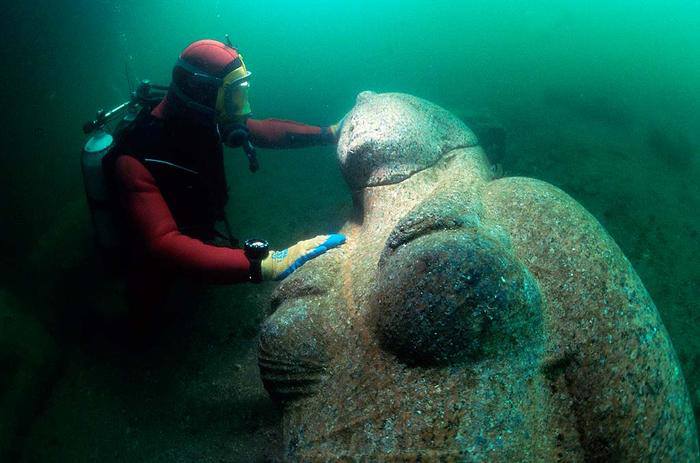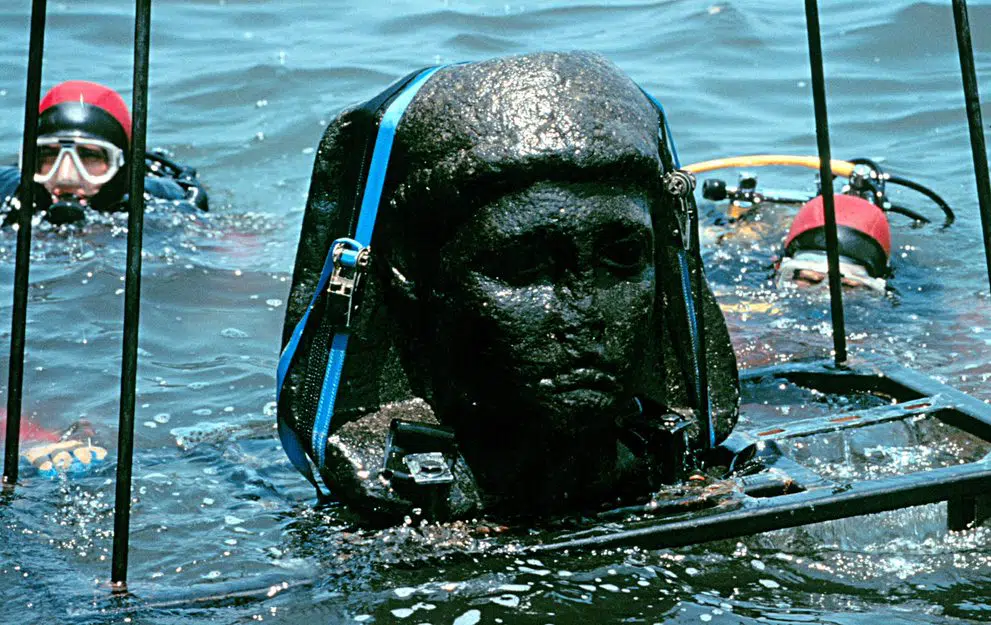
Franck Goddio, the marine archaeologist who discovered the underwater city of eastern Alexandria and Heracleion, Egypt, will hold a presentation in December highlighting many of the discoveries he has made in the last 25 years.
The talk, which will be open to the public, will show the incredible images of his scuba-diving research in the waters outside the Hellenistic-era city of eastern Alexandria, including monuments, statues and buildings that toppled into the sea and were subsequently forgotten for centuries.
The underwater port of eastern Alexandria was explored by Goddio beginning in 1992. In the year 2000, the newly city of Heracleion, which was once the largest port in Egypt, was also discovered underwater after more than 2,000 years. Its legendary beginnings go back to as early as the 12th century BC, and it has many links to Ancient Greece.
The zone of research covers the current eastern port, which measures approximately 400 hectares in area. After an extensive program of electronic surveys to create an accurate map of the harbor floor, archaeological remains buried under the sediment were located by selective mechanical soundings and through the use of electronic detection instruments such as nuclear magnetic resonance (NMR) magnetometers.
The archaeological campaigns have made it possible to develop, for the first time, a complete panorama of the famous Portus Magnus. The topography obtained is very different from what had been previously imagined from ancient texts. We now know how the eastern port of Alexandria looked during the Ptolemaic and Roman Periods.
Heracleion, Egypt was Hellenistic-era center of Mediterranean trade near Alexandria
Flourishing as long ago as the waning days of the Pharaohs, the city of Heracleion, just 30 km east of Alexandria, was later destroyed as the city was weakened by a combination of earthquakes, tsunamis and rising sea levels, according to archaeologists.
At the end of the 2nd century BC, most likely after a severe flood, the monumental buildings of Heracleion collapsed into the water. Some of its inhabitants stayed in what was left of the city during the Roman era and the beginning of Arab rule, but by the end of the eighth century AD, the rest of Heracleion had sunk beneath the Mediterranean.
Now, in an online presentation called “The Portus Magnus of Alexandria”, sponsored by the Oxford Centre for Maritime Archaeology (OCMA) and live-streamed by the University of Oxford on December 2 at 5 pm GMT, Goddio will present the results of his 25 years of groundbreaking research in the port of eastern Alexandria.
The European Institute for Underwater Archaeology (IEASM), directed by Goddio, began his underwater explorations in cooperation with the Egyptian Ministry of Antiquities and with the support of the Hilti Foundation.

After extensive electronic surveys and decades of excavation work, Goddio created an accurate map of the ancient harbor, allowing many of the archaeological remains buried under centuries of sediment to be brought to light once again.
Important monuments and numerous artifacts from the city’s legendary Portus Magnus have now been identified, and the landscape on which they once stood in the Hellenistic era of Egypt, has been revealed.
A complete panorama of the Portus Magnus has been developed, thanks to Goddio, tracing how the port, with its military and commercial infrastructure, palaces and temples, changed over the years. The picture he obtained sometimes considerably differed from descriptions in ancient texts — demonstrating the importance of rigorous scientific investigation into the archaeological evidence.
Goddio’s presentation, which will be livestreamed, is aimed at the general public and can be attended for free by visiting this web page.
“This is a major event”, says Damian Robinson, director of the OCMA. “For the first time the life history of this amazing port and its submergence will be set out. It promises to be a fascinating journey from the cutting edge survey technology used to pinpoint detailed excavation, through the analysis of the rediscovered objects, to the detailed interpretations of how the port changed through the Egyptian, Ptolemaic and Roman periods.”
Goddio’s lecture is part of a seminar series organized by the OCMA entitled “Alexandria and the Sea”. The series aims to bring together scholars working on diverse aspects of the relationship between the ancient city of Alexandria and its connections with the maritime world via its Portus Magnus.
The Oxford Centre for Maritime Archaeology (OCMA) is a specialist research project within the School of Archaeology at the University of Oxford. It is devoted to the study of people who live or work on and around water.
In Egypt, the OCMA collaborates on projects implemented by the European Institute for Underwater Archaeology (IEASM), under the direction of Franck Goddio and supported by the Hilti Foundation. The OCMA also promotes research through a vigorous programme of international conferences that bring together specialists in maritime cultures, as well as outreach events aimed at a more general audience.
The Centre’s peer-reviewed monograph series is published in-house and distributed by Oxbow Books. The series includes excavation reports, specialist object analyses, and edited thematic volumes based upon OCMA conferences.
The European Institute for Underwater Archaeology (IEASM) was founded in 1987 as a French non-profit organization by its President, Franck Goddio. Its aim is the location, exploration, excavation and restoration of sunken sites. The IEASM calls upon scientists and specialists from different scientific fields to support its research missions and to study and publish their findings. It also sets up exhibitions allowing the general public to get access to its discoveries.
The Hilti Foundation is a philanthropic organization that aims to contribute to building a better future. With its clearly focused activities in the areas of “Music for Social Change”, “Affordable Housing & Technology”, “Economic Empowerment” and “Emergency Relief”, it addresses specific topics that are among today’s major global challenges. By supporting the work of Franck Goddio and the IEASM since 1996, the Hilti Foundation has made a lasting contribution to innovation in underwater archaeological research. Associated with the goal of making the results accessible to both the scientific community and the broader public.
See all the latest news from Greece and the world at Greekreporter.com. Contact our newsroom to report an update or send your story, photos and videos. Follow GR on Google News and subscribe here to our daily email!



